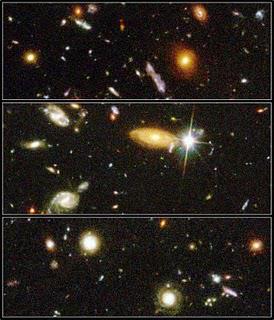 Spiral galaxies are the most common type and our galaxy is a spiral galaxy. These galaxies are characterized by curved, spiral structure that wrap the nucleus. In the spiral arms are young, hot, blue stars. Those galaxies along with the thermonuclear reaction creates heavier elements that are evicted after their death in inter-stellar space. From the materials of old stars the youth star that contain heavier elements are born. Unlike them, the nucleus galaxy consists of mostly old stars with some heavy elements, and in this region a few young stars are born.
Spiral galaxies are the most common type and our galaxy is a spiral galaxy. These galaxies are characterized by curved, spiral structure that wrap the nucleus. In the spiral arms are young, hot, blue stars. Those galaxies along with the thermonuclear reaction creates heavier elements that are evicted after their death in inter-stellar space. From the materials of old stars the youth star that contain heavier elements are born. Unlike them, the nucleus galaxy consists of mostly old stars with some heavy elements, and in this region a few young stars are born.Unlike ordinary spiral galaxy they with a bar have spiral arms that do not come directly from the nucleus but from the bars, which cuts through the nucleus. It is believed that the bar are created with a natural evolution of galaxies. Computer simulations show that bars formed when orbiting stars reciprocally act on each other's gravitational force. Then why do not all spiral galaxies have bars? One theory says that it creates an obstacle in the presence of large amounts of dark matter.
The nucleus is always yellow or reddish in color because it contains older stars. Arms or "external" part of spiral galaxies is bluish tones because it contains most of the young hot stars. Spiral galaxies usually consist of two components: a flat disk that contains most of the interstellar material, and stars and young (open) clusters and the spherical components - halo - which contains an older stellar population without interstellar material, often with many globular clusters of stars.
